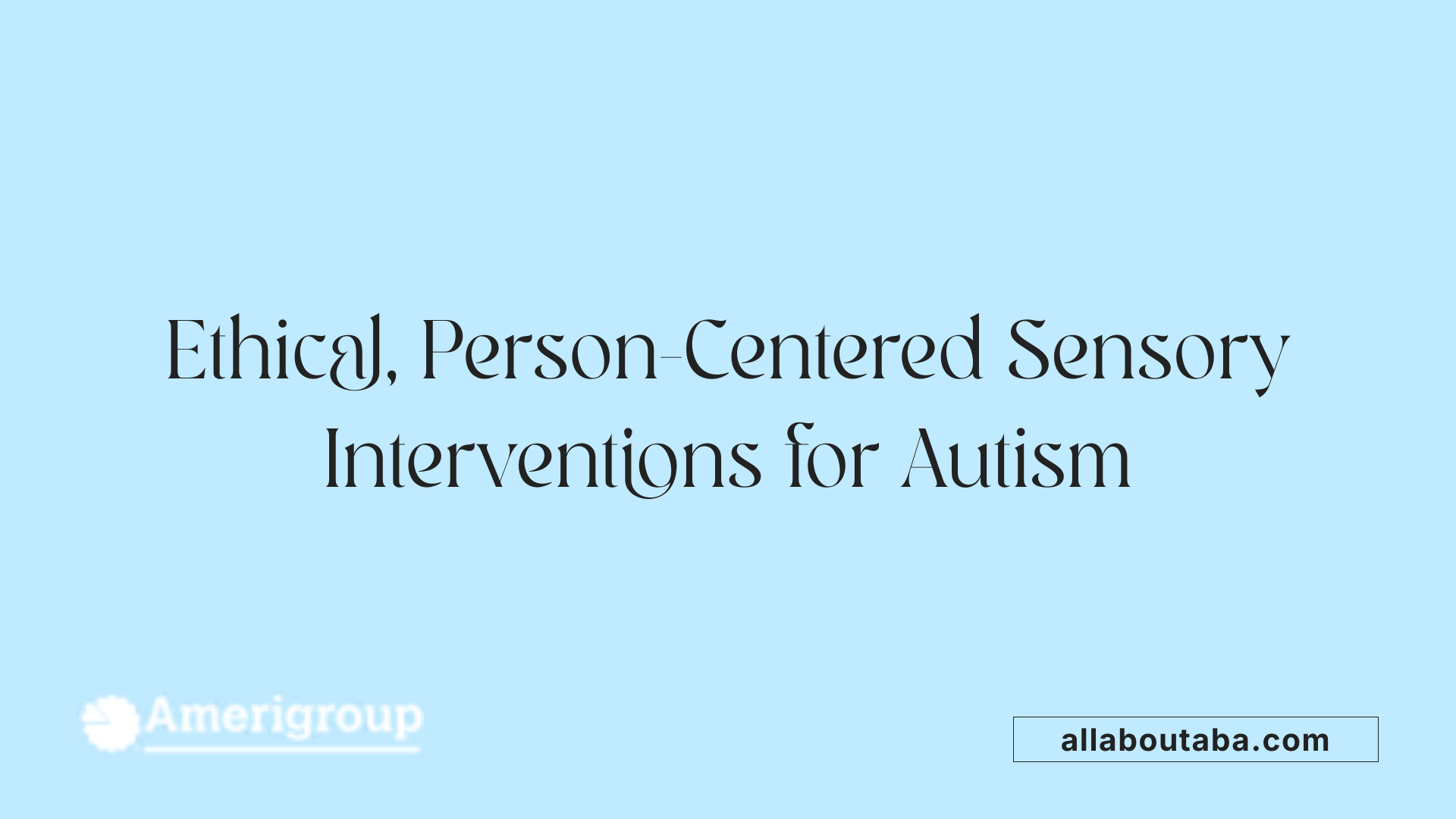How To Address Tactile Defensiveness In Autism
Understanding Tactile Defensiveness in Autism
Tactile defensiveness, a common sensory processing challenge among individuals with autism spectrum disorder (ASD), often significantly impacts daily living and social participation. This heightened sensitivity to touch can trigger discomfort, anxiety, and avoidance behaviors, making basic interactions and self-care routines difficult. Addressing tactile defensiveness requires a multifaceted approach involving specialized therapies, tailored sensory strategies, and collaborative care. This article explores effective interventions and expert insights into managing tactile defensiveness to improve comfort and independence in individuals with autism.
The Role of ABA Therapy in Autism Treatment
What is Applied Behavior Analysis (ABA) therapy and how is it used in autism treatment?
Applied Behavior Analysis (ABA) therapy is a scientifically supported method that applies learning and behavior principles to enhance socially significant skills in individuals with autism. It focuses on analyzing behavior to identify what triggers it and what consequences follow, using techniques such as positive reinforcement, prompting, and the antecedent-behavior-consequence (A-B-C) model.
How does ABA target socially significant skills in autism?
ABA breaks down vital skills like communication, social interaction, self-care, and academics into manageable, teachable steps. These steps are practiced and reinforced consistently, promoting skill acquisition and generalization.
What are the techniques such as positive reinforcement and the A-B-C model?
- Positive reinforcement: Rewarding desired behaviors to increase their frequency.
- A-B-C model: Understanding the sequence of Antecedents (triggers), Behaviors, and Consequences to modify behavior effectively.
- Prompting: Providing cues or assistance to encourage target behavior, gradually faded to promote independence.
How is individualized treatment planning applied in ABA?
Each ABA program is personalized based on the unique strengths and needs of the individual. Board Certified Behavior Analysts (BCBAs) design and oversee these tailored plans, ensuring goals are relevant and attainable.
What evidence supports ABA effectiveness?
Research shows ABA improves language, social skills, and reduces problem behaviors, especially when initiated early and delivered intensively.
Why is family participation important in ABA?
Active involvement of families supports skill generalization across settings and reinforces consistency, increasing therapy effectiveness.
Table: ABA Therapy Components
| Component | Description | Role in Therapy |
|---|---|---|
| Positive Reinforcement | Rewarding desired behaviors | Increases target behaviors |
| A-B-C Model | Understanding behavior triggers and outcomes | Guides behavior modification strategies |
| Individualized Planning | Tailored goals based on assessment | Ensures therapy meets specific needs |
| Family Participation | Caregiver involvement and training | Enhances consistency and skill generalization |
Qualifications of Professionals Delivering ABA Therapy

Who typically provides ABA therapy and what qualifications do they have?
ABA therapy is typically provided by qualified professionals such as Board Certified Behavior Analysts (BCBAs) and trained therapists who specialize in behavioral interventions for autism. These professionals usually hold advanced degrees, like a Master of Science, and have completed specific coursework in applied behavior analysis.
Roles of Board Certified Behavior Analysts (BCBAs)
BCBAs design and oversee ABA intervention programs. They assess individual needs, develop treatment plans, and supervise therapy sessions to ensure effective application of behavioral principles.
Training, certification, and educational requirements for ABA providers
To become a BCBA, candidates must meet rigorous educational requirements, complete substantial supervised fieldwork hours, and pass a comprehensive certification exam. Many also pursue additional training through programs such as the Advanced Certificate in ABA.
Verification by Behavior Analysis Certification Board (BACB) and ABA International (ABAI)
Certification by the BACB and accreditation from ABAI confirm that providers meet recognized standards of knowledge and professionalism in ABA therapy.
Additional state licensure such as New York State ABA Licensure
In certain states, practitioners obtain state-specific licensure like New York State ABA Licensure, which adds an extra layer of regulatory oversight and ensures compliance with local laws.
Importance of professional qualifications for effective and ethical ABA interventions
Qualified and certified professionals are essential to deliver effective, evidence-based, and ethical ABA interventions, ultimately supporting positive outcomes for individuals receiving therapy.
Benefits and Challenges of ABA Therapy in Autism
What are the benefits and challenges associated with ABA therapy for autism?
Applied Behavior Analysis (ABA) therapy offers numerous benefits for individuals with autism spectrum disorder (ASD). One of the primary advantages is the improvement in communication, social skills, and daily living tasks, which helps enhance overall functioning. Many individuals benefit from increased independence and better academic abilities. ABA also effectively reduces problematic behaviors, including aggression and self-injury, which can significantly improve quality of life for both individuals and their families.
ABA is a highly individualized and evidence-based approach. Therapists use techniques like positive reinforcement and regular behavioral assessments to tailor interventions specifically to each person's needs and preferences. This customization ensures the therapy addresses unique challenges and promotes meaningful progress.
However, ABA therapy presents some challenges. It is often time-intensive, requiring many hours each week, which can be demanding for families and individuals. Responses to treatment can vary widely, meaning not everyone experiences the same level of benefit. Additionally, ethical concerns have emerged regarding the potential for trauma or overly intensive procedures within ABA. Contemporary practices strive to minimize these risks by emphasizing ethical standards, positive reinforcement, and person-centered care.
Caregiver collaboration is another vital aspect of successful ABA therapy. Engaging families ensures that skills learned during sessions generalize to daily life, supporting sustained improvements. Prioritizing goals that enhance independence and quality of life remains central to therapy planning.
In summary, ABA therapy can be highly effective when applied thoughtfully and ethically. Regular evaluation, use of naturalistic methods, and active input from stakeholders help to maximize the benefits and address challenges inherent to this approach.
Understanding Sensory Integration Therapy for Tactile Defensiveness
What Is Sensory Integration Therapy and Its Goals?
Sensory integration therapy is a treatment designed to help children who struggle with processing sensory information, such as touch, movement, and sound. Its primary goal is to improve how children respond to sensory stimuli, making them feel more comfortable and better able to manage everyday activities.
How Do Occupational Therapists Support This Therapy?
Occupational therapists play a vital role by observing children and working alongside caregivers to develop personalized treatment plans. These plans often include sensory diets—structured schedules of sensory activities—that can be continued at home or school to support ongoing progress.
What Activities Are Common in This Therapy?
Some typical activities include swinging, crashing into pillows, and spinning. These actions provide controlled sensory input that helps children with tactile defensiveness become more accustomed to different sensations in a safe and supportive environment.
How Does Therapy Address Tactile Defensiveness?
Tactile defensiveness involves an overreaction to touch. Techniques such as brushing with the Wilbarger protocol offer deep pressure stimulation that can reduce sensitivity. Parents are often trained to perform these techniques at home, reinforcing therapy effects.
What Are Clinical Perspectives on Sensory Processing Issues in ASD?
Experts like A. Jean Ayres and Lucy Jane Miller recognize that sensory processing difficulties are common among children with autism spectrum disorder (ASD). While sensory integration therapy aims to improve sensory responses, some professionals remain cautious about claims suggesting it can 'rewire' the brain. Nonetheless, many families report positive improvements in comfort and self-regulation.
The Use of Sensory Gyms and Equipment in Therapy

What are sensory gyms and what tools do they use?
Sensory gyms are specially designed therapy spaces equipped with a variety of tools to help children with sensory processing challenges. Common equipment found in these gyms includes swings, weighted vests, ball pits, and squeeze machines.
How do swings, weighted vests, ball pits, and squeeze machines assist therapy?
- Swings provide rhythmic movement that can soothe the vestibular system, aiding balance and spatial awareness.
- Weighted vests offer deep pressure stimulation, which helps calm and organize sensory input.
- Ball pits create a tactile-rich environment, allowing children to experience varied textures and pressure.
- Squeeze machines simulate firm hugging pressure that can reduce anxiety and tactile defensiveness.
How do these tools provide calming pressure and sensory input?
These devices deliver controlled sensory experiences, like deep pressure and motion, that help regulate a child's nervous system. This sensory input can reduce hyperactivity and improve focus by making the child feel grounded and secure.
How do sensory gyms support children in feeling comfortable and regulated?
By engaging in these activities, children often develop greater comfort with sensory experiences that once overwhelmed them. The calming effects assist in self-regulation, enabling improved behavior and emotional stability in different settings.
How do play-based sensory activities encourage engagement?
The interactive and fun nature of the activities in sensory gyms turns therapy into play. This playful approach motivates children to participate willingly, enhancing the therapeutic benefit and making sensory integration a positive experience.
Brushing Techniques and Deep Pressure Stimulation
What is the Wilbarger Protocol and How is it Used?
The Wilbarger protocol is a specialized brushing technique applied in sensory integration therapy to provide deep pressure stimulation. Therapists use a soft surgical brush to repeatedly stroke a child’s arms, legs, and back, which can help reduce tactile defensiveness—a condition where children are overly sensitive to touch.
Why is Deep Pressure Stimulation Important for Tactile Defensiveness?
Deep pressure stimulation helps calm the nervous system by providing a consistent, firm sensation. For children with tactile defensiveness, this input can make them feel more secure and less overwhelmed by everyday tactile experiences. The pressure helps normalize how the brain processes touch, making physical contact more comfortable.
How Are Parents and Caregivers Involved?
Occupational therapists often train parents and caregivers to perform these brushing techniques safely at home. By integrating brushing into daily routines, families can ensure children receive regular deep pressure input, enhancing therapy outcomes outside clinical settings.
What Benefits Are Reported with Regular Brushing?
Families report that consistent deep pressure through brushing can improve children’s tolerance to touch, reduce anxiety, and aid in better self-regulation. This ongoing input supports the effectiveness of sensory integration therapy and helps children adapt to sensory challenges more easily.
How Does Brushing Fit into a Sensory Diet?
Brushing is often combined with other activities in a sensory diet—a personalized schedule of sensory inputs designed by therapists. Including brushing ensures children receive targeted tactile stimulation alongside other sensory experiences to promote overall sensory comfort and function.
Vestibular, Visual, and Auditory Therapies to Support Sensory Processing
What Are Vestibular, Visual, and Auditory Therapies?
Vestibular, visual, and auditory therapies focus on improving how the brain processes movement, sight, and sound. These therapies help children with sensory processing issues, especially those who face challenges in balance, spatial awareness, and responding to sensory stimuli.
Examples of These Therapies
Two notable approaches include listening programs and astronaut training. Listening programs use specially designed music to stimulate the auditory system, helping children filter and process sounds better. Astronaut training involves spinning to music, which targets the vestibular system—the part of the inner ear responsible for balance and spatial orientation. This fun and dynamic activity can help children become more comfortable with movements that might otherwise feel overwhelming.
Enhancing Spatial Awareness and Balance
By engaging these sensory systems through specific exercises, children improve their understanding of body position and movement in space. This enhancement supports better coordination and balance, making daily activities and learning experiences more manageable.
How Do These Therapies Complement Other Interventions?
While tactile therapies address touch sensitivities through methods like brushing and pressure, vestibular, visual, and auditory therapies work alongside them. Together, they create a comprehensive sensory integration approach that addresses multiple senses and supports overall development.
Goals of These Therapies
The main goal is to improve overall sensory integration, helping children respond to sensory information in a more balanced and adaptive way. This contributes to increased comfort, better self-regulation, and improved function at school and home environments.
Developing Sensory Diets for Home and School Environments
What Is a Sensory Diet and Why Is It Important?
A sensory diet is a personalized schedule of sensory activities designed to help children with sensory processing challenges manage their sensory needs throughout the day. These diets aim to provide the right amount and type of sensory input to help children feel calm, focused, and more comfortable in various settings.
How Do Therapists and Caregivers Collaborate?
Occupational therapists observe each child carefully and work closely with caregivers to tailor sensory diets that fit individual needs. This teamwork ensures that the activities are practical and can be integrated smoothly into daily routines at home and school.
Incorporating Sensory Activities into Everyday Life
Sensory diets typically include activities like swinging, deep pressure exercises, and the use of sensory tools. These can be scheduled before challenging tasks or during transition times to help regulate sensory input.
Sensory Tools Commonly Used at Home
Families often use weighted blankets to provide calming pressure, fidget toys to offer manageable physical activity, and other tactile tools that children can use independently. These tools assist children in self-regulating their sensory experiences throughout the day.
Creating Environments That Reduce Sensory Overload
Adapting the home or classroom by establishing quiet spaces helps children retreat when overwhelmed. Reducing visual clutter by organizing and simplifying surroundings also minimizes unnecessary sensory stimulation, making it easier for the child to stay calm and focused.
Family and Caregiver Roles in Managing Tactile Defensiveness
Importance of Family Involvement in Therapy Plans
Families play a crucial role in the success of sensory integration therapy for children with tactile defensiveness. Occupational therapists closely collaborate with caregivers to tailor treatment plans that fit the child's unique needs.
Training Caregivers to Implement Sensory Diets and Therapies
Caregivers receive specific training on how to carry out sensory diets at home, including the application of brushing techniques like the Wilbarger protocol. This hands-on involvement ensures continuity of therapy outside clinical settings, helping children receive consistent sensory input.
Creating Supportive Home Environments
Parents are encouraged to adapt home environments by setting up quiet spaces and reducing visual clutter. They also often provide sensory tools such as weighted blankets and fidget toys that help soothe and regulate the child's sensory responses.
Monitoring Progress and Adjusting Interventions
Ongoing observation by caregivers allows for timely feedback to therapists, facilitating adjustments in therapy plans to better support the child's evolving needs. This collaboration ensures that interventions remain effective and responsive.
Emotional and Practical Support for Families
Families not only implement therapy strategies but also provide emotional support, fostering a nurturing atmosphere. Sharing progress and challenges with therapists and support groups helps caregivers feel understood and empowered throughout the therapeutic journey.
Clinical Evidence and Reports on Sensory Integration Therapy Outcomes
Families’ anecdotal reports of improvement in comfort and functioning
Many families report that sensory integration therapy significantly enhances their children's comfort and daily functioning. Children often become better equipped to handle sensory stimuli, which helps them participate more fully in school and at home. These improvements are linked to increased ease in self-regulation and reduced sensory-related distress.
Clinical applications corroborating positive effects
Occupational therapists use sensory integration therapy as a practical approach to address sensory processing challenges. Through tailored plans involving sensory diets and activities like swinging and deep pressure techniques, clinicians observe improvements in children's ability to manage sensory information more effectively. These observations support the positive outcomes reported by families.
Impact on self-regulation, school participation, and daily life
Therapy interventions aim to improve children's self-regulation skills, enabling better emotional and behavioral control. Enhanced sensory processing allows children to engage more confidently in school settings and perform everyday tasks with greater independence and comfort. Sensory diets and environmental adaptations further support these gains.
Limitations and professional caution regarding brain rewiring claims
While some proponents suggest that sensory integration therapy can 'rewire' the brain, many professionals express skepticism regarding this claim. The therapy's success is better understood as helping children develop improved sensory responses rather than inducing fundamental neurological changes.
Expert opinions from authorities like A. Jean Ayres and Lucy Jane Miller
Experts such as A. Jean Ayres, the pioneer of sensory integration theory, emphasize that sensory processing issues are prevalent among children with autism spectrum disorder (ASD). Lucy Jane Miller highlights the importance of structured sensory activities to improve sensory responses. Both acknowledge the benefits of sensory integration therapy but caution against overstatement of its neurological impact.
Combining ABA and Sensory Integration Approaches

Complementary Roles of ABA and Sensory Integration Therapy
Applied Behavior Analysis (ABA) primarily focuses on modifying observable behaviors through reinforcement techniques, helping children develop skills and reduce challenging behaviors. Sensory integration therapy, on the other hand, targets a child’s sensory processing challenges by using activities like swinging, spinning, and deep pressure techniques. Together, these therapies address both behavioral and sensory needs, creating a more holistic support system for children.
ABA’s Focus on Behavior Modification Alongside Sensory Strategies
While ABA therapists work on behavior goals such as communication and social interactions, they often recognize the importance of sensory challenges that may underlie or trigger behaviors. Integrating sensory strategies—such as those found in sensory diets or calming activities—can reduce sensory discomfort that might contribute to behavioral issues. This integration allows ABA programs to be more individualized and responsive to the child’s sensory needs.
Benefits of Integrating Sensory Activities with Behavioral Goals
Incorporating sensory activities like brushing techniques or vestibular input within behavioral interventions can improve a child’s self-regulation and attention, enhancing their ability to participate in ABA sessions. For example, using weighted blankets or fidget tools before or during tasks may calm the child and boost engagement. This synergy supports improved outcomes both in therapy sessions and everyday environments like home and school.
Importance of Interdisciplinary Collaboration Among Therapists
Effective integration requires collaboration between occupational therapists specializing in sensory integration and ABA therapists. Sharing observations and treatment strategies ensures that plans complement each other rather than work in isolation. Caregivers too play a critical role in coordinating these therapies by applying sensory diets at home in conjunction with ABA routines.
Maximizing Child Outcomes Through Coordinated Interventions
By combining ABA’s structured behavior modification with sensory integration techniques, children can benefit from a comprehensive approach that addresses multiple aspects of their development. This coordinated intervention often results in improved comfort, better self-regulation, and enhanced functioning across settings, ultimately supporting the child’s overall growth and quality of life.
Creating Personalized, Ethical Approaches to Sensory Challenges in Autism

Why is individualized and person-centered intervention important?
Children with sensory processing issues, especially those on the autism spectrum, exhibit diverse sensory needs. Occupational therapists carefully observe each child and collaborate with caregivers to develop tailored sensory diets. These are structured schedules of sensory activities designed specifically for the child’s unique challenges and preferences, ensuring they feel more comfortable and engaged.
How can ethical considerations be addressed in therapy delivery?
Ethical sensory integration therapy respects the child’s limits and avoids overly intense stimulation. Techniques such as the Wilbarger protocol for brushing should only be applied with professional guidance and parental consent. Transparency about the therapy’s goals and realistic outcomes prevents misconceptions, especially regarding claims of 'rewiring' the brain which remain controversial among experts.
How is the balance between intervention intensity and sensitivity maintained?
Therapists carefully balance activities like swinging, crashing, or spinning to provide calming sensory input without overwhelming the child. Use of sensory gyms, weighted vests, and quiet spaces allows adjustment of stimulus intensity according to the child’s responses. Continuous monitoring ensures that therapy remains both effective and comfortable.
What role does ongoing evaluation and adjustment play?
Sensory integration therapy is dynamic. Therapists and families regularly evaluate the child’s progress, modifying sensory diets and environmental adaptations as needed. This ongoing adjustment helps maintain optimal treatment benefits and addresses evolving sensory needs.
Why prioritize quality of life and independence?
The ultimate goal of sensory therapies is improving a child’s ability to function at school and home, fostering self-regulation and comfort in daily life. By empowering caregivers with training and creating supportive environments, therapies encourage independence and enhance overall quality of life for children with autism.
Moving Forward with Compassionate Care for Tactile Defensiveness
Addressing tactile defensiveness in autism is a complex but vital task that greatly enhances an individual’s quality of life. Through evidence-based therapies such as Applied Behavior Analysis and sensory integration techniques, combined with active family involvement and professional expertise, children and adults with autism can achieve greater comfort, improved self-regulation, and increased independence. By embracing ethical, personalized, and multidisciplinary approaches, caregivers and clinicians can foster environments where sensory sensitivities are effectively managed, allowing individuals with autism to thrive socially, academically, and emotionally.
References
- Treating Sensory Processing Issues
- Applied Behavior Analysis - School of Education
- Applied Behavior Analysis (ABA)
- Applied Behavior Analysis (ABA)
- A Treatment Summary of Applied Behavior Analysis
- Applied Behavior Analysis in Children and Youth with ...
- Treatment and Intervention for Autism Spectrum Disorder
- Applied Behavior Analysis (ABA)
- Concerns About ABA-Based Intervention: An Evaluation ...
Other articles
Recent articles

Best Practices For Transitioning Autistic Children Into New Schools

Autism And Time Management Challenges In Adulthood

The Role Of Visual Arts In Autism Communication Development

How To Address Tactile Defensiveness In Autism

Best Practices For Telehealth Autism Therapy

How To Help Autistic Children Develop Friendship Skills

How Schools Can Support Autistic Students In Career Prep

Best Strategies For Autism-Friendly Event Planning

Understanding Noncontingent Reinforcement In Autism Behavior Plans

How Drama Therapy Benefits Autistic Individuals

Best Practices For Autism-Friendly Fitness And Recreation Centers

Best Ways To Promote Healthy Social Media Use For Autistic Teens

How To Help Autistic Children Cope With Public Speaking

Autism And Strategies For Managing Unexpected Changes

Best Podcasts About Autism For Parents And Educators

Autism And The Impact Of Seasonal Changes On Behavior

The Role Of Diet In Managing Co-Occurring Conditions With Autism

Sleep Challenges In Autism And Practical Solutions

Best Ways To Build Daily Routines For Autistic Children

Best Practices For Supporting Autistic Entrepreneurs

Autism And Strategies For Navigating Large Social Gatherings

Adaptive Sports And Recreational Activities For People With Autism

Autism And The Benefits Of Story-Based Learning Activities

Understanding The Role Of Play In Autism Development

Autism And The Impact Of Environmental Noise On Learning

How To Create Autism-Friendly Community Spaces

Autism And Chronic Health Conditions: What To Know

The Role Of Care Managers In Autism Life Planning

How To Teach Social Boundaries To Autistic Children

How Autistic Individuals Experience Empathy Differently

How To Support Autistic Employees In Remote Work Settings

Autism And The Relationship Between Motor Skills And Learning

How To Create Community Resource Guides For Autism Families

How To Teach Daily Living Skills To Autistic Teens

Autism And The Impact Of Mind-Body Practices On Stress Reduction

Autism And The Benefits Of Outdoor Group Activities

How To Create Autism-Friendly Sensory Paths In Schools

Best Practices For Autism-Friendly Park And Recreation Areas

Autism And Strategies For Reducing School Refusal

Supporting Autistic Individuals In Public Speaking

The Role Of Diet In Managing Autism Symptoms

The Benefits Of Gardening Clubs For Autism Social Development

How To Prepare Autistic Children For Dental Visits

Autism And Employment: Career Paths That Work

Best Practices For Autism-Friendly Hotels And Lodging

The Impact Of Screen Time On Autism Development

Autism Screening Tools For Early Childhood

The Role Of Physical Exercise In Autism Therapy

Best Strategies For Supporting Autistic College Students

The Role Of Technology In Autism Early Detection

Sensory-Friendly Classroom Design Ideas For Autistic Students

The Role Of Speech Therapy In Building Social Communication Skills

Best Strategies For Handling Autistic Burnout In Adults

Autism And The Importance Of Predictability In Routine

Autism And Peer Education: Teaching Acceptance In Schools

Best Practices For Sensory-Friendly Libraries And Reading Rooms

Self-Advocacy Skills For Autistic Adults

The Role Of Technology In Autism Peer Communication

Promoting Physical Activity In Children With Autism

How To Prepare Autistic Children For Medical Procedures

The Role Of Social Media In Autism Advocacy And Awareness

The Impact Of Sensory Rooms In Public Facilities For Autism

How To Create An Autism-Friendly Holiday Celebration

Best Practices For Inclusive Education For Autistic Students

Autism And Mental Health: Recognizing Signs Of Distress

Best Practices For Sensory-Friendly Waiting Rooms

The Role Of Teachers In Early Autism Red Flag Identification

Autism-Friendly Housing Design Features

Autism-Friendly Housing Design Features

How Environmental Modifications Improve Autism Outcomes

Autism And Technology-Based Learning Tools

Supporting Autistic Children Through Changes In Routine

The Link Between Autism And Working Memory Challenges

Best Practices For Autism-Friendly Cooking Classes

Autism And The Benefits Of Structured Music Lessons

Best Books To Teach Kids About Autism Acceptance

Sensory Diets And Their Benefits For Autism Management

How To Prepare Autistic Teens For Driver’s Education

How To Teach Autistic Teens About Healthy Relationships

The Role Of Visual Prompts In Building Daily Habits For Autism

Addressing Sleep Regression In Children With Autism

Understanding Social Stories And How They Help Autistic Children

Navigating Insurance Coverage For Autism Therapy Services

How To Prepare Autistic Adults For Independent Travel

Supporting Autistic Individuals In Volunteer Work

How Mindfulness Practices Can Support Autism Well-Being

Understanding Hyperfocus And Special Interests In Autism

Understanding Stimming As A Self-Regulation Tool

Sensory-Based Interventions For Autism At Home

Best Ways To Introduce Self-Advocacy In Autistic Teens

Best Ways To Support Autistic Employees In Customer Service Roles

Best Practices For Autism-Friendly Volunteer Programs

Autism And The Benefits Of Sensory Play For Emotional Growth

Autism And Strategies For Building Peer Relationships

Understanding How Autism Affects Memory Processing

Autism And Strategies For Building Coping Skills In Teens

The Role Of Parent Training In Autism Intervention Programs

Autism-Friendly Workplace Accommodations

Using Visual Timers For Autism Time Management

What Is ABA Therapy?
We’re All About You, Your Family, and Your Child

